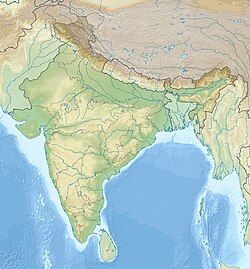Top Qs
Timeline
Chat
Perspective
Jawaharlal Nehru Port
Second largest container port in India From Wikipedia, the free encyclopedia
Remove ads
Jawaharlal Nehru Port, also known as JNPT and Nhava Sheva Port, is the second largest container port in India after Mundra Port.[4][5] Operated by the Jawaharlal Nehru Port Trust Authority (JNPTA), it is located on the eastern shores of Arabian Sea in Navi Mumbai, Raigad district, Maharashtra. This port can be accessed via Thane Creek, a nodal city of Navi Mumbai.[6] It is the main port of the Mumbai Metropolitan Region after Mumbai Port, also of Maharashtra and Western India. Its common name derives from the names of Nhava-Sheva (new sheva) village that is situated here. It is also the terminal of the Western Dedicated Freight Corridor.
As of January 2023, the port is undergoing upgrades with the help of a loan agreement signed between the Asian Development Bank (ADB) and Nhava Sheva Freeport Terminal Private Limited (NSFTPL). The loan of $131 million will be used to improve the terminal's infrastructure, increase its container handling capacity, upgrade existing berths and yards, and install energy-efficient equipment. The upgrades aim to attract vessels and make international trade more efficient, transparent and sustainable.[7]
Remove ads
History
Summarize
Perspective
The port was established on 26 May 1989 and became the second largest and premier container handling port in India,[8][9] surpassing the capacity of 4 million TEUs (Twenty-foot equivalent units) in containers between 2016 and 2021.
JNP consists of a full-fledged customs house, 30 container freight stations and connectivity to 52 inland container depots across the country. The hinterland connectivity both by rail and road is being further strengthened by ongoing projects like the Dedicated Freight Corridor (DFC), which will increase the existing train capacity from 27 to 100 trains per day; Multi-Modal Logistics Park (MMLP) and widening of the port's connecting roads. Its proximity to the cities of Mumbai, Navi Mumbai and Pune; airports, hotels, exhibition centres, etc. gives the port an edge in efficiency and promptness to address the shippers’ needs.
In 2006, the port implemented the logistics data tagging of containers.[10]
JNPT houses India’s best logistics connectivity with facilitation from container freight stations and logistics parks owned by government as well as private players namely Maharashtra State Warehousing Corporation, DRT, Gateway District Park, Allcargo, Avashya, Continental Warehousing, Ameya Logistics, TransIndia and Contegrate Entrepot. JNPT authorities have been trying to implement direct port delivery model of the containers, a first of its kind model promoted to ease doing business in India.
Nhava Sheva Freeport container terminal
The JNP Trust (JNPT) Container Terminal was originally operated by JNPT. It has a quay length of 680 metres (2,230 ft) with 3 berths.[11]

In 2023 Nhava Sheva Freeport Terminal Private Limited commenced operations of the terminal (renamed to the NSFT terminal) and plans to enhance it to handle 1.8 million TEUs by 2025.[12]
Nhava Sheva International container terminal
The Nhava Sheva International Container Terminal (NSICT) was originally leased to a consortium led by P&O, a part of DP World. Commissioned in July 2000, it has a 600 metres (2,000 ft) quay length with two berths. It was intended to handle up to 62.15 million tonnes of cargo.[13] NSICT was India’s first privately managed container terminal.
GTI-APM container terminal
In the year 2006, GTI (Gateway Terminals India Pvt Ltd) commissioned a third container terminal operated by APM Terminals, with the capacity to handle 1.3 million TEUs.
Bharat Mumbai container terminal
The fourth container terminal, Bharat Mumbai Container Terminal (BMCT), is developed and operated by PSA International. Phase 1 with capacity of 2.4 million TEUs was completed in Dec 2017. The terminal was planned to have full capacity of 4.8 million TEUs p.a. and a quay length of 2,000 meters with the completion of Phase 2.

Nhava Sheva (India) Gateway container terminal
A new standalone container terminal by the name of NSIGT, having a quay length of 330 meters and a capacity of 0.8 million TEUs was operational in July 2016.
Remove ads
Traffic

Major exports from Jawaharlal Nehru Port are textiles, sporting goods, carpets, textile machinery, boneless meat, chemicals, and pharmaceuticals. The main imports are chemicals, machinery, plastics, electrical machinery, vegetable oils, and aluminium and other non-ferrous metals. The port handles cargo traffic mostly originating from or destined for Maharashtra, Madhya Pradesh, Gujarat, Karnataka, as well as most of North India.
Remove ads
See also
References
External links
Wikiwand - on
Seamless Wikipedia browsing. On steroids.
Remove ads



